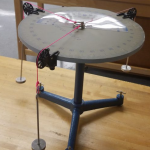Force Table: Balance of Forces
Purpose
To determine the force that balances two other forces applied on an object.
Objectives
- To learn how to use vectors to represent physical forces.
- To become proficient in drawing vectors and adding them graphically
- To learn proficient in calculating force components from magnitude and direction
- To learn learn how to apply conditions for equilibrium of forces.
Equipment
- Force table with a ring, set of weights,
- Three hooks with pulley clamps and strings
- Mass scale
- Graphing paper
Theory
If a 2-dimensional vector has magnitude of
and direction given by an angle θ measured from the positive x axis, then its components are given as:
Alternatively, if you know the components of the vector, and
, then the magnitude and angle are given as:
Remember! Check the quadrant the location of angle θ. The calculator will give you answers either in I-st or IV-th quadrant. If that is not the case, you will have to add 180o.
Setup
 Attach strings to the ring and place the ring at the center of the Force Table.
Attach strings to the ring and place the ring at the center of the Force Table.
Place 150 g on a 50-g hook (for a total of 200 g) and hang it at 30o
Place 100 g on a 50-g hook (for a total of 150 g) and hang it at 135o
Experiment
Determine the tension in the third string and at what angle so that the ring is balanced, that is it is at the exact center of the table.
A. Angle
Hold by hand and pulling the third string at different angles until you determine at what angle the ring is balanced. Write it down.
B. Tension
Set up the last pulley clamp at the angle, and hang the 50-g hook on the string. Add weights until the ring is balanced. Record the total mass hanging.
Calculations
Record the magnitude and direction of all three forces. Calculate their x- and y- components.
| Force | Hanging Mass | Magnitude | Direction | Fx | Fy |
|---|---|---|---|---|---|
| 1 | 200 g | ||||
| 2 | 150 g | ||||
| 3 |
Analysis and Assignments
A1. Add all three x-components, and all three y-components.
Question: Is the total x-component equal to zero? Is the total y-component equal to zero?
A2. Draw and
on graphing paper. Using the parallelogram rule, draw their sum
Question: Is the vector for the third force equal in magnitude but opposite in direction to the sum
